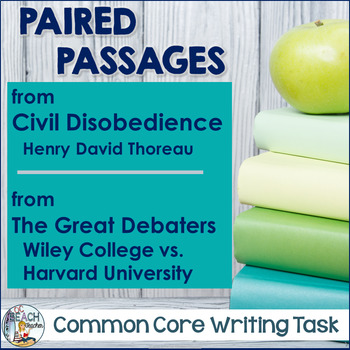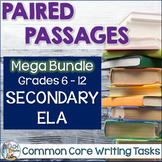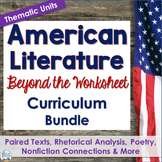Paired Texts - Civil Disobedience and The Great Debaters - Essay Writing Lesson
- PDF
Also included in
- These 19 paired passages (using 39 texts) require students to use close reading, critical thinking, and analytical writing to help them prepare for standardized assessments. In each lesson, students synthesize their reading, identifying central ideas and themes across texts. With texts that vary byPrice $44.99Original Price $72.15Save $27.16
- Are you new to American Literature or tired of boring worksheets? Engage students with texts by American authors in lessons that use real-world learning connections, an appreciation for cultural diversity, and critical thinking skills. These activities for your American Literature Curriculum are orPrice $104.99Original Price $206.71Save $101.72
- These lessons and activities make teaching argumentative writing and rhetorical analysis easy! Use argument writing bell ringers, an argument research essay unit, rhetorical appeals task cards, research activities, paired texts, graphic organizers, and a rhetorical appeals trashketball game to diffePrice $31.49Original Price $62.14Save $30.65
Description
In this lesson, which incorporates science of reading strategies, students complete close readings of an excerpt from Henry David Thoreau’s “Civil Disobedience” and the debate scene “Wiley College vs. Harvard University” from the movie The Great Debaters (which can be used with or without viewing the movie). Then, they synthesize their understanding of the readings and write a short analytical essay requiring them to analyze the arguments in the texts.
This 30-page resource includes the following:
-explicit lesson plan with identified Common Core ELA Anchor Standards
-anticipation guide
-contextual reading guides
-think aloud with sample annotation passage
-essay and scene texts
-analysis graphic organizers
-Venn diagram
-essay writing prompt
-short analytical essay rubric
-key (with detailed responses for all activities and a sample essay)
Incorporating all strands of the Common Core English Language Arts (ELA) Anchor Standards, this "paired passages" lesson encourages students to practice skills in annotation, rhetorical and literary analysis, and essay writing. Students complete handouts using before-, during-, and post-reading strategies, which provide scaffolding for diverse learners. Afterwards, they respond to a writing task that imitates the style of a standardized assessment.
With its detailed instructions and samples, this resource would make an excellent lesson for a substitute if you will be out for a couple of days.
In addition to the printable lesson, this resource may be used for distance and online learning with EASEL by TpT.
If you like this resource, you may want to view these other Paired Passages lessons in my store:
We Shall Overcome & Second Inaugural Address
The Man He Killed and The Sniper
The Tell Tale Heart and Sonnet 100
Going paperless? Here are digital versions of these Paired Passages:
Digital Writing Task: Road Not Taken & Harlem
Digital Writing Task Resource Ain't I a Woman? and Phenomenal Woman
Digital Writing Task We Wear the Mask & I'm Nobody
You can find all of these writing tasks here:
Meaningful and Memorable English Language Arts by © OCBeachTeacher ™
All rights reserved by author.
Limited to use by purchaser only.
Group licenses available.
Not for public display.








